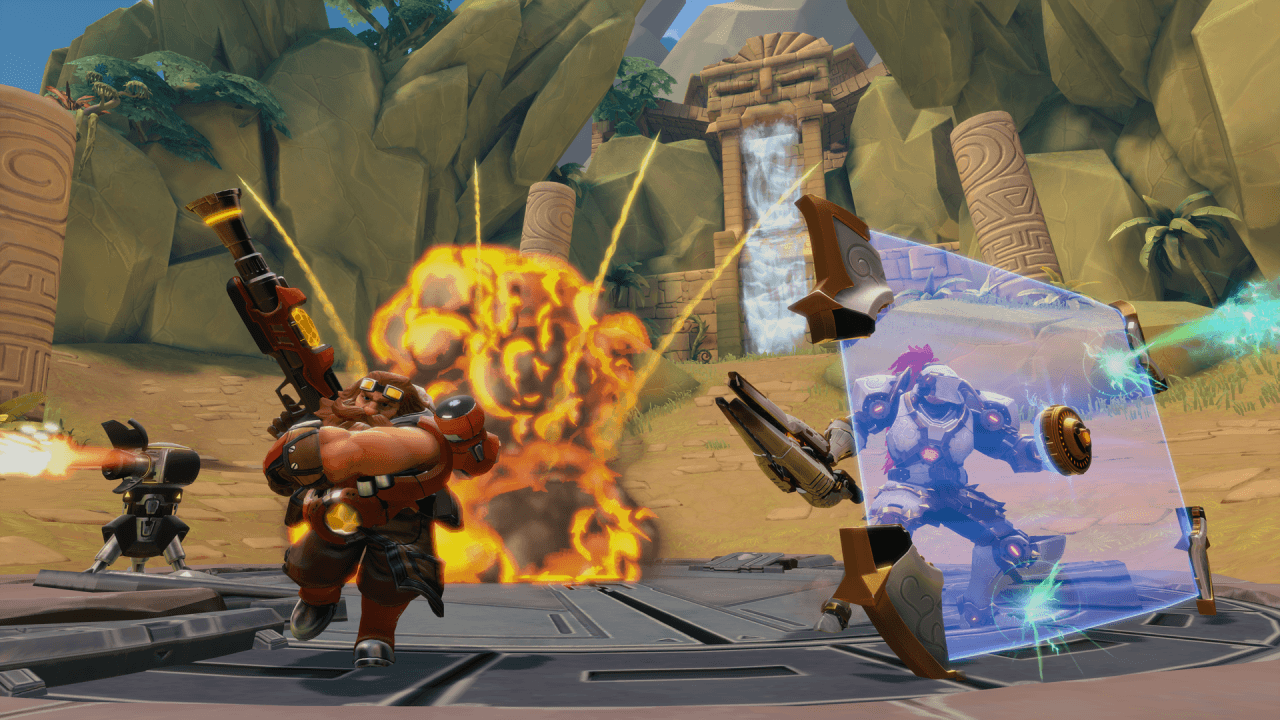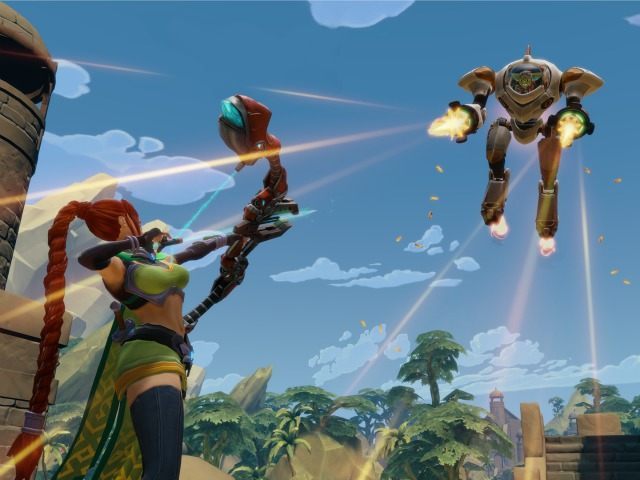After tackling skiing space marines and warring deities, Hi-Rez’s next major project mashes their previous ideas together. Paladins is the intriguing product of a combination of genres, but it still has a long way to go.
Paladins is first and foremost a role-based arena shooter, owing a lot of its central gameplay to the likes of Team Fortress. It also isn’t shy about its roots in SMITE — it owes more of its design decisions to the MOBA genre than its competitors, at least in the form in which it currently exists. It’s also managed to splice in a bit of Hearthstone’s DNA, putting the collection and building of your deck of cards at the forefront of progression in the metagame.
Two teams of five players square off on one of several planned battlefields, from temple ruins to forests and icy strongholds. There are a bevy of characters on the roster to fill all of the traditional roles, from tanking and damage-dealing to squad support with their various abilities. During a match, you’ll level up in MOBA fashion, gaining experience from completing objectives and killing members of the opposing team.
As you level, you’ll draw hands of cards from a customizable deck. From that hand — weighted toward weaker and more common cards early on, then toward more powerful effects in the latter part of the patch — you will choose from various advantages. You might simply gain more health or damage, but you also may gain augmentations that enhance or modify the ways that your abilities work altogether.
Matches predominantly take place in Siege mode, a tug-of-war event similar to Team Fortress 2‘s Payload maps. Each team will make alternate attempts to attack and defend various points of the map, which will then cause siege engines to spawn and progress toward the enemy base. Upon reaching it, those siege engines will need to be destroyed before they can do too much damage to the team’s “vault.” It continues until one team’s vault is breached — very similar to the defeat of a titan in SMITE, or the destruction of a base nexus in League of Legends or Dota 2.

The other two modes — Capture and Assault, respectively — are each about half of Siege. Capture has no siege engines. Claiming five points on the map in a row nets you a victory, without the need to escort and defend the giant vault-breaching cannon. Assault is the reverse: Siege engine spawns alternate between the teams and go on their way, with or without you holding territory or needing to escort them to their destination.
There are currently nine champions to choose from, with several more being polished for release. Even so, the roster feels a bit thin currently. This early in development, such limitations are expected. Still, with a line-up that features a turret-toting dwarven engineer, a purple-haired femme assassin, and an agile anthropomorphic fox, it’s hard to find something about it that doesn’t just feel like it was copy/pasted in.
It’s not that Paladins is bad at this point in its development cycle. On the contrary, what is already there can be a lot of fun when teams are competitively matched and you’re several minutes into your upgrades. It’s that right now we’re looking at a veritable wall of similar games heading toward us simultaneously, and right now Paladins doesn’t have a personality that sets it apart. It’s the attractive yet unclothed mannequin of a title that could be compelling, but it needs something more to distinguish itself.
Overwatch is guilty of much the same in its character and level design, but the sheer weight of Blizzard’s budget allows them a level of polish that for the most part excuses the underlying lack of originality. Paladins doesn’t have the same wiggle room — they’re putting a single scoop of vanilla ice cream up against an entire ice cream truck, and so far the cards are little more than sprinkles.
That’s because, so far, the purported key feature of Paladins isn’t all that dynamic. Again, this is subject to change dramatically; Hi-Rez is intent on adding far more to what is already present. For now, however, it feels as if the deck-building is little more than busywork. The effects don’t yet change much in how a character is played by anyone below the top tier of competitive play, and they don’t have enough flavor to be amusing on their individual merits.

Despite the team’s emphasis on building a deck to suit your play style, right now they’re riding in the deep ruts of their MOBA forebears. The champions dictate your experience, with allowances made for someone to be able to take or dish out just a bit more. Because of that, the limited champion pool and bland characterization is all the more apparent.
The levels also feel very flat and a bit too large. For a game that lives and dies on pacing, you spend a lot of time just lumbering toward a contested objective. The development team is looking to change that, but for the moment there just isn’t much to see during your inevitably repeated hikes toward battle. Some variation in level design, especially vertically speaking, would go a long way toward making it feel like less of a slog.
It’s hard to communicate the very real optimism I still have for the game’s progress, despite some sticking points in the design so far. Games change a lot over the course of their development, and Hi-Rez has made a name in exposing their work to the public for feedback far earlier than most major studios would tolerate.
I have hope for the game, mostly because of the precedent set by the high-flying speed rush of Tribes: Ascend and the uniquely engaging conceits of SMITE. Much like the in-game cards, the studio has shown a propensity for mixing and matching their best people for each title in order to find the sweet spot. If the roster can develop a unique personality, the cards be given a bit more impact, and the level design evolve into something that feels less like the lane-trudging necessities of a MOBA, Hi-Rez could easily stake a claim on the latest competitive sub-genre fad.
It’s just not quite there yet.
Editor’s note: Hi-Rez Studios paid for travel and lodging accommodations in attending the SMITE World Championship 2016.
Follow Nate Church @Get2Church on Twitter for the latest news in gaming and technology, and snarky opinions on both.

COMMENTS
Please let us know if you're having issues with commenting.